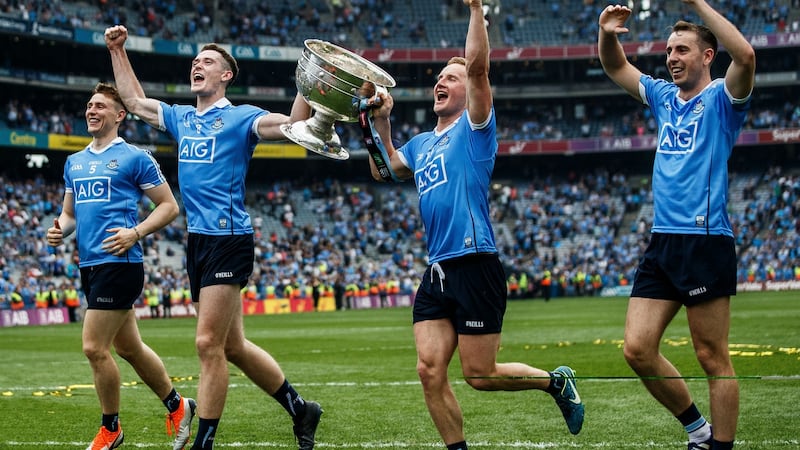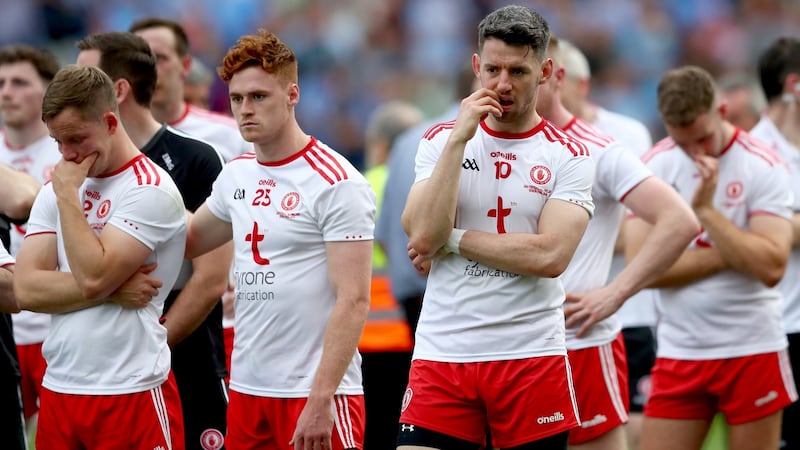The beast is out of the cage.
Watching the Dublin players celebrate on the field yesterday, I found myself torn between admiration for what they have achieved and the way they conduct themselves and genuine fear about how the football landscape is going to look in 10 years’ time.
Jim Gavin’s team completed a fourth All-Ireland title in a row without any opposing team really laying a glove on them. The quest of that elusive fifth title gives them a singular motivation for next year.
But why stop there?
Being honest, it is easier to imagine Dublin as champions for the next three summers – at least – than it is to put forward a plausible argument as to what other teams will not only match them for athleticism and power but overtake them on the scoreboard. They have left the field far, far behind.
Tyrone gave it an honest go on Sunday but even during that slightly surreal opening period when they raced into the lead, I found myself fearful for what was unfolding on the pitch.
All of the pundits were insistent that this was the only way to tackle Dublin; to go man-to-man and push up. But in doing so, you leave yourself incredibly exposed. The pre-match changes to the Tyrone team, with Conor Meyler and Rory Brennan coming in, gave the stadium a clear statement of intent from Mickey Harte. He selected athletes to go man-to-man across the field with Colm Cavanagh dropping back to sweep. He wanted to put pressure on and force the issue and push up on the kick-outs. And in fairness, it worked in the opening exchanges.
They were doing so much right, generating a huge percentage of possession and moving the ball slickly in the build-up and had the capacity to do damage when they kept their composure. They were sharp, their movement was excellent with Mark Bradley, in particular, extremely bright in everything that he did.
Dublin showed they can make decisions in real time. And after 20 minutes, they had figured out the runs and spaces and shut them off
But even with that and the number of possessions they won, I just felt there was a total malfunction in their shot selection. It looked rushed and it undid all the promise of the approach work. It created a situation where they were forcing their shots at the critical moment. I counted about six narrow angled, outside-of-the-boot shots which are very low percentage strikes over the course of a game.
In the middle of that purple patch, there was a brilliant turnover and then Niall Sludden tried a wild shot. The same happened with Peter Harte. Things looked rosy on the scoreboard but those two shots, from two of Tyrone's key men, had alarm bells ringing for me.
One-on-one battles
What Mickey Harte gambled on was middle-third pressure. It was something that Mayo did a lot against Dublin in those big games as well. But when you go man-to-man against Dublin, it invariably becomes a series of one-on-one battles when a player becomes isolated. Then, the game is reduced to an elemental struggle featuring power and speed. And Dublin will win more of those than they lose.
So that was a problem that became more prevalent as the game wore on and we saw Paul Mannion, Ciarán Kilkenny, Jack McCaffrey, Eoin Murchan and Brian Fenton in the ascendency. They absolutely thrive in that scenario.
But that was not even the main problem.
For me, the main problem was that when Dublin were moving the ball in transition and attacking Tyrone’s 45, I counted about five or six occasions when you had Tyrone players marking other Dublin players out around the 65.

In other words, the ball – and therefore the danger – was 20 yards up field but they were sticking to their designated player as if to say: ‘I am covering my man, I am doing my job’. If you play a match-up man-to-man defence with that mentality, then you are absolutely cooked. You have to be willing, collectively, to abandon a player who is posing no present danger in order to put out fires elsewhere.
You have to collapse on the ball-carrier. The obedience with which the Tyrone’s outfield 14 stuck to their men left huge spaces for Dublin to make really dangerous and deep incisions. In that kind of environment, you are effectively playing Russian roulette against Dublin. Goals became all but inevitable.
And the reality is that both tactics could have worked simultaneously, creating serious middle-third pressure while also dropping off to deal with Dublin on the break.
In the early stages of the game, Niall Morgan gave an exceptional kick out performance. But yet again, Dublin showed they can make decisions in real time. And after 20 minutes, they had figured out the runs and spaces and shut them off. There was absolutely no out-ball for Morgan.
Tyrone could have solved that problem easily. They could have gone with three full backs and half backs narrow and the three half forwards in front of those two lines also narrow, pushing their two midfielders out beyond the halfway line. And just try and hit those midfielders and either fetch the ball or break it and try and make it a battle out there. Even if they don’t secure possession, they still have nine players behind the ball and are in position to control the transition by Dublin. So the same dynamic is at play here: Tyrone could remain dangerous from their kick-out while also protecting themselves in the event of losing possession.
It is aggravating because they can point to innumerable instances that could have made a difference
Instead, they were all fanned out over the pitch and Dublin had each option covered. Once they won the ball: bang: two passes and they were in. The space down the centre of the field for the move that led to Dublin’s penalty was emblematic of the problem.
A malfunction
So forget that Tyrone had a malfunction up front. Just that tactic could have kept them in the final much longer. Once they conceded those first-half goals, their task became impossible. In addition, it was obvious Tiernan McCann was struggling to stay with Ciarán Kilkenny and I felt a switch was needed there.
Through all of this, Dublin's decision-making and work rate was exceptional. So I felt Jim Gavin and the forwards must have been delighted half way through the first half to find themselves in such an open game with the opportunity to transition into attack mode as soon as they got possession.

At one stage, Dean Rock was advancing with the ball and he had multiple options left and right as he pierced the centre of the Tyrone defence. It was staggering to see. So once Dublin reversed their fortunes on the scoreboard in that lightning blitz, they assumed control of the game.
In the second half, they were in cruise control. That period where they retained possession for almost two minutes was class from their perspective. We saw, late on, once again, that they have this vulnerability under the oldest tactic in the game – the long ball into the square. The very first time Tyrone applied it, they got a penalty and their goal. But that was the 67th minute. I felt they should have at least tried it a few times in the first half. Just to see.
Dublin's full potential has just begun to be harnessed and nobody can be fully sure what that will mean
Tyrone’s perseverance was admirable; they were out on their feet for the last quarter but were still within four points going into injury time. It is aggravating because they can point to innumerable instances that could have made a difference – their 16 wides, kick-outs, needless fouls – and convince themselves that they were right in the contest.
But that is an illusion. The result was never in doubt. The reality is Dublin pose so many challenges. Even when they lost John Small, it remained a top-class performance. They just sharpened the pencil; ran harder, played with more conviction. Three passes (Cluxton–Fenton–Macauley) moved the ball the length of the pitch and finished with a point that removed any fleeting question of a late shock. Just as everyone suspected at the beginning of this All-Ireland championship, they had too much, were too fast and are too good.
Serious operation
So this empire creates a lot of questions in a lot of counties as to where to go from here. Dublin are so well coached and critically, it would appear their fitness levels are beyond that of any other team. That becomes hard to handle over 80 minutes.
The other critical shift within this era has been the culture Jim Gavin has created. He has cut out the media and sensationalism that surrounded the team and has created a very closed and quiet camp. There is a lot genuine respect for opposition within the group and they don’t over-egg it when they are celebrating. These attributes were absent in the years when Dublin reliably imploded. Now, there is a very obvious high-performance culture; they are a serious operation.
Who can beat them?
Mayo have yet to appoint a new manager and it remains to be seen whether their warriors have another big summer in them. Kerry are brimming with young creative players but that won’t solve the serious issues they have in their full-back line right now. Can Tyrone reimagine their attack and finishing before next summer?
There is no doubt these teams and others will redouble their efforts over the coming winter. But the truth is Dublin's full potential has just begun to be harnessed and nobody can be fully sure what that will mean.









